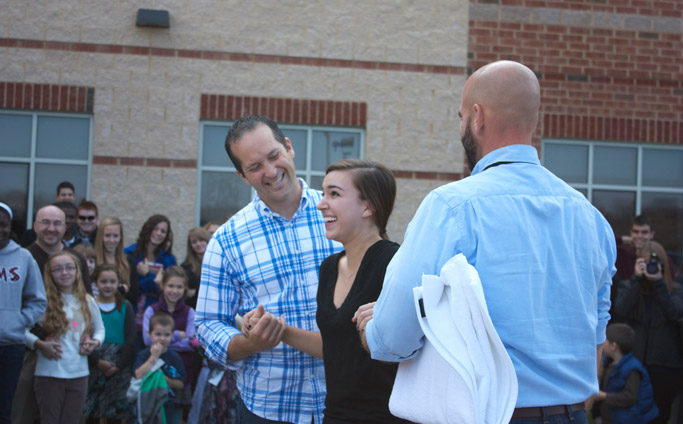How we’ve learned to make disciples at Eastside Church
by VMC Staff
In March, we celebrated five years of ministry. I marvel at what has happened. As I look back here is what I think we got right.
1. Major in plagiarism
I often joke about the church planting courses I avoided like the plague in seminary. I had no plans to be a church planter! Whoops! So when the call to plant came, it arrived with a profound awareness that I didn’t know anything about church planting! I had to become a learner!
I recognized that I knew little, so I studied and stole liberally from other church planters. I majored in plagiarism: I read everything I could, I trusted those who had planted successfully since I didn’t have my own prior knowledge, and I copied their strategies like a boss. I talked to and visited with church planters. Most of our best strategies are copied from someone else.
I felt a tremendous weight as we began. I knew that new churches reach the lost, disenfranchised and institutionally abused; a new church might be their last chance. They deserved my absolute best effort.
.
“From the beginning we put people in charge of anything they were, or were willing to be, passionate about.”
.
2. Study your location and target
I researched census information, had conversations with school administrators and spent eight years researching my city. Just knowing the demographics of our city transformed my understanding of who was marginalized and absent from other churches in the town. I always had a hunch that churches were not reaching those 20 to 45-year-olds, but research proved it.
We were going after un-churched, de-churched and any other people who were not already attending. I studied the un-churched even more than I did church planting. I wanted to know who they were, where they were, and why they didn’t come. That continues today—I love reading new studies and often spend hours trying to understand what they are sharing. I still listen to stories, but knowing the research helps to distinguish the antidotal from seismic shifts.
.

Eastside Church recently celebrated the baptism of a JMU student. Researching local demographics and learning the best strategies for reaching the under-reached has enabled Eastside better walk with new disciples. Photo courtesy of Peter Eberly
.
3. Build a stable
Studying the location and learning the best strategies enabled us to cast a very clear vision. That vision attracted a few well-formed leaders who longed to join in God’s action and collaborate with us. We committed to training and walking with anyone who had a desire to grow. We made room for leaders who were tired of attending churches that their un-churched friends wouldn’t attend. We also encouraged folks who weren’t sold on the vision to attend somewhere else.
From the beginning we put people in charge of anything they were, or were willing to be, passionate about. Disciples are learners, so when you start from scratch you have the opportunity to work with lots of disciples. What better opportunity to train fellow learners than providing immediate opportunity. We continue to be committed to training and walking with other disciples and recently made a huge budget shift in order to reflect that. I have massive limitations but I decided early on to invite others to fill the gap.
4. Small groups
We began meeting in small groups months before corporate worship. We gathered in homes, met for meals and studied the word. That is essential to our core identity. We regularly say from the pulpit, “If you are not in a small group, we really can’t help you.”
Small groups have steep learning curves. Some groups were home runs but most have adapted and evolved. We are committed to small groups so we discovered we had to be flexible with how they function. How we meet, what we studied, and our basic structures are constantly in flux. We are committed to small groups, so we are equally committed to be flexible in how they work.
5. Aim for who you hope to be
We know the Church is always growing, so we planned to be a growing worshipping community. We structured ourselves to grow–we didn’t want to limit anyone from becoming a disciple of Jesus! A simple example is our weekly worship gathering. We planned for growth, so we found a space that could accommodate 80 and 400. This enabled us to shift as we saw the growth and attendance swells. Our main problem was aiming too low. Traditional churches are constantly stuck in facilities that limit their size, scope and ministry. The great commission is for the world—we didn’t want to be limited by our foresight, imagination or facilities.
6. Clarity of vision, clarity of vision!
Clarify your vision statement! If it isn’t clear, people can’t use it. Hab 2:2 says “Write the vision, make it plain on tablets, so he may run who reads it.” We have a repeatable and profoundly simple mission statement. Everyone hears it at least one time and sees it at least three times each Sunday. We talk about it in our messages, elders meetings and small groups. We are on guard for mission drift (when repeatable patterns, carriers of history, a building and a budget determine direction). Our plan is to have every regular attender learn our vision and how they can join in it. Our budget, ministry and language is determined by our vision and mission so that we are flexible and adaptive.
7. My wife is a saint!
The best piece of advice I ever received about church planting was to make sure my wife was on board. I’m married and my wife is the best. However, planting a church is spiritually, emotionally, physically and financially difficult. Planting has been hard (a joy at least 85% of the time) but a challenge. If I had dragged her into this, she would have left the church or me. When I felt the call I shared the vision with her and waited. I repeatedly assured her that if God didn’t speak to her, then I had heard wrong.
Sure enough, God began to lay a passion for those outside the church on her heart. She meets new people far easier than I do. She has that face you meet in the grocery store and the next thing you know, you are sharing your most intimate joys and pains with them.
The pastor’s family will be attacked when you plant—mix that with the challenges of serving—and it is a recipe for challenge. If God calls you, He called your spouse too.
